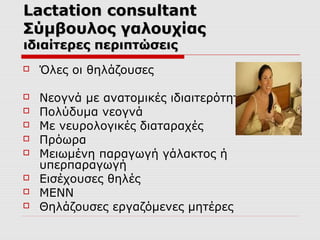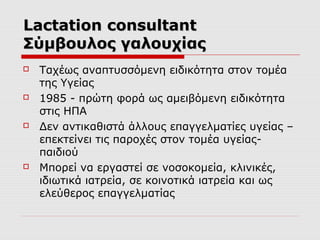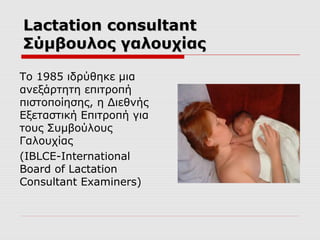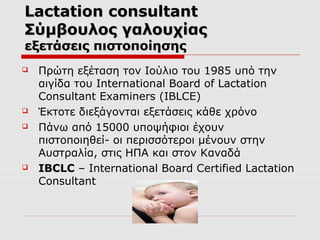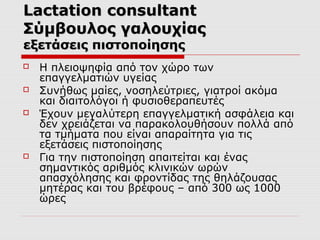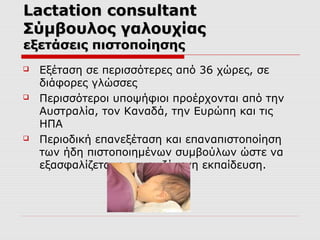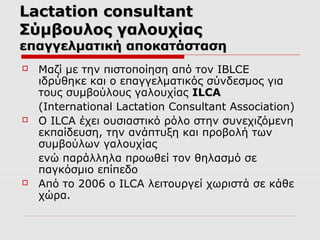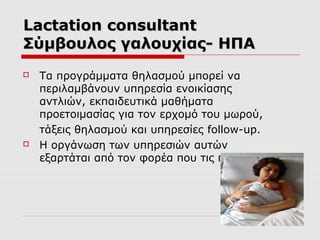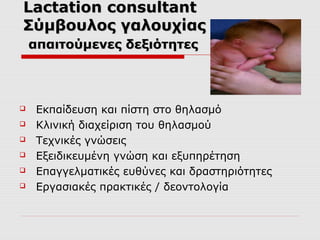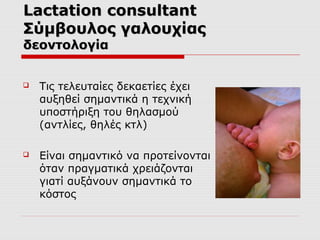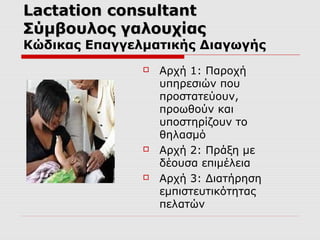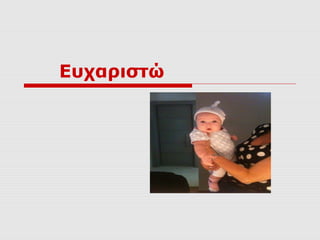More Related Content Similar to Lactation consultant (9) More from Sofia Liosi (8)
Survivin Survivin
Sofia Liosi ╠²
This study investigated umbilical cord blood concentrations of the protein survivin in pregnancies complicated by intrauterine growth restriction (IUGR) or large-for-gestational age (LGA) babies due to gestational diabetes, and compared them to appropriate-for-gestational age (AGA) controls. The study found no statistically significant differences in survivin concentrations between the three groups. Additionally, survivin levels were independent of factors like birthweight, gestational age, gender, mode of delivery, and parity. The study concludes that cord blood survivin levels do not reflect disturbances in fetal-placental apoptosis seen in IUGR and LGA pregnancies.
Ficolins Ficolins
Sofia Liosi ╠²
This study aimed to determine cord blood concentrations of H- and L-ficolin in pregnancies with normal fetal growth (AGA) and restricted fetal growth (IUGR). The study found no significant differences in cord blood concentrations of H- and L-ficolin between the IUGR and AGA groups. Additionally, factors like birthweight, gestational age, and maternal characteristics did not significantly affect cord blood H- and L-ficolin concentrations. The researchers concluded that H- and L- ficolin are likely not directly implicated in the pathophysiological processes of IUGR given the lack of differences between groups.
Tgf ╬▓1 europaediatrics 2009 Tgf ╬▓1 europaediatrics 2009
Sofia Liosi ╠²
This study investigated transforming growth factor beta 1 (TGF-╬▓1) concentrations in umbilical cord blood from pregnancies complicated by intrauterine growth restriction (IUGR) compared to appropriate-for-gestational-age (AGA) controls. The study found no significant differences in TGF-╬▓1 concentrations between the IUGR and AGA groups. Higher TGF-╬▓1 concentrations were associated with vaginal delivery and lower infant growth percentiles in the IUGR group. The results suggest TGF-╬▓1 may be related to fetal growth but not directly involved in pathophysiological processes leading to IUGR.
Tgf a europaediatrics 2009 Tgf a europaediatrics 2009
Sofia Liosi ╠²
Cord blood TGF-╬▒ concentrations were measured in 160 pregnancies, including 110 appropriate for gestational age (AGA) and 50 intrauterine growth restricted (IUGR) cases. No significant differences were found in TGF-╬▒ levels between the IUGR and AGA groups. TGF-╬▒ levels were higher in vaginal deliveries compared to cesarean sections. The results suggest that cord blood TGF-╬▒ levels at term are not affected by IUGR and are increased by the stress of vaginal delivery.
Calprotectin europaediatrics 2009 Calprotectin europaediatrics 2009
Sofia Liosi ╠²
Cord blood calprotectin concentrations were measured in 160 full-term pregnancies, including 110 appropriate for gestational age (AGA) controls and 50 with intrauterine growth restriction (IUGR). No significant differences in calprotectin levels were found between the AGA and IUGR groups. Calprotectin levels were significantly lower in cases delivered by cesarean section compared to vaginal delivery. Within the IUGR group only, calprotectin levels increased significantly with advancing gestational age and higher birthweight.
2. Lactation consultant
╬ŻŽŹ╬╝╬▓╬┐Žģ╬╗╬┐Žé ╬│╬▒╬╗╬┐ŽģŽć╬»╬▒Žé ŌĆō Žä╬╣ ╬Ą╬»╬Į╬▒╬╣;
’ü»
╬Ģ╬╣╬┤╬╣╬║╬¼ ╬Ą╬║ŽĆ╬▒╬╣╬┤╬ĄŽģ╬╝╬Ł╬Į╬┐Žé ŽāŽä╬╣Žé
╬▒╬Į╬¼╬│╬║╬ĄŽé ŽĆ╬┐Žģ ╬▒Žå╬┐Žü╬┐ŽŹ╬Į Žä╬Ę
╬┤Žģ╬¼╬┤╬▒ ╬Ė╬Ę╬╗╬¼╬Č╬┐ŽģŽā╬▒Žé
╬╝╬ĘŽä╬ŁŽü╬▒Žé ╬║╬▒╬╣ ╬▓Žü╬ŁŽå╬┐ŽģŽé
’ü»
╬Ö╬║╬▒╬ĮŽīŽé ╬Į╬▒ ŽĆŽü╬┐╬╗╬▒╬╝╬▓╬¼╬Į╬Ą╬╣,
╬Į╬▒ ╬▒╬Į╬▒╬│╬ĮŽēŽü╬»╬Č╬Ą╬╣ ╬║╬▒╬╣ ╬Į╬▒
╬╗ŽŹ╬Į╬Ą╬╣ Žä╬╣Žé ŽĆ╬╣╬Ė╬▒╬Į╬ŁŽé
╬┤ŽģŽā╬║╬┐╬╗╬»╬ĄŽé ŽĆ╬┐Žģ ŽĆ╬▒Žü╬┐ŽģŽā╬╣╬¼╬Č╬Ą╬╣
╬┐ ╬Ė╬Ę╬╗╬▒Žā╬╝ŽīŽé
3. Lactation consultant
╬ŻŽŹ╬╝╬▓╬┐Žģ╬╗╬┐Žé ╬│╬▒╬╗╬┐ŽģŽć╬»╬▒Žé
╬╣╬┤╬╣╬▒╬»Žä╬ĄŽü╬ĄŽé ŽĆ╬ĄŽü╬╣ŽĆŽäŽÄŽā╬Ą╬╣Žé
’ü»
╬ī╬╗╬ĄŽé ╬┐╬╣ ╬Ė╬Ę╬╗╬¼╬Č╬┐ŽģŽā╬ĄŽé
’ü»
╬Ø╬Ą╬┐╬│╬Į╬¼ ╬╝╬Ą ╬▒╬Į╬▒Žä╬┐╬╝╬╣╬║╬ŁŽé ╬╣╬┤╬╣╬▒╬╣Žä╬ĄŽüŽīŽä╬ĘŽä╬ĄŽé
╬Ā╬┐╬╗ŽŹ╬┤Žģ╬╝╬▒ ╬Į╬Ą╬┐╬│╬Į╬¼
╬£╬Ą ╬Į╬ĄŽģŽü╬┐╬╗╬┐╬│╬╣╬║╬ŁŽé ╬┤╬╣╬▒Žä╬▒Žü╬▒Žć╬ŁŽé
╬ĀŽüŽīŽēŽü╬▒
╬£╬Ą╬╣Žē╬╝╬Ł╬Į╬Ę ŽĆ╬▒Žü╬▒╬│Žē╬│╬« ╬│╬¼╬╗╬▒╬║Žä╬┐Žé ╬«
ŽģŽĆ╬ĄŽüŽĆ╬▒Žü╬▒╬│Žē╬│╬«
╬Ģ╬╣Žā╬ŁŽć╬┐ŽģŽā╬ĄŽé ╬Ė╬Ę╬╗╬ŁŽé
╬£╬Ģ╬Ø╬Ø
╬ś╬Ę╬╗╬¼╬Č╬┐ŽģŽā╬ĄŽé ╬ĄŽü╬│╬▒╬ČŽī╬╝╬Ą╬Į╬ĄŽé ╬╝╬ĘŽä╬ŁŽü╬ĄŽé
’ü»
’ü»
’ü»
’ü»
’ü»
’ü»
’ü»
4. Lactation consultant
╬ŻŽŹ╬╝╬▓╬┐Žģ╬╗╬┐Žé ╬│╬▒╬╗╬┐ŽģŽć╬»╬▒Žé
’ü»
’ü»
’ü»
’ü»
╬ż╬▒Žć╬ŁŽēŽé ╬▒╬Į╬▒ŽĆŽäŽģŽāŽāŽī╬╝╬Ą╬Į╬Ę ╬Ą╬╣╬┤╬╣╬║ŽīŽä╬ĘŽä╬▒ ŽāŽä╬┐╬Į Žä╬┐╬╝╬Ł╬▒
Žä╬ĘŽé ╬ź╬│╬Ą╬»╬▒Žé
1985 - ŽĆŽüŽÄŽä╬Ę Žå╬┐Žü╬¼ ŽēŽé ╬▒╬╝╬Ą╬╣╬▓Žī╬╝╬Ą╬Į╬Ę ╬Ą╬╣╬┤╬╣╬║ŽīŽä╬ĘŽä╬▒
ŽāŽä╬╣Žé ╬Ś╬Ā╬æ
╬ö╬Ą╬Į ╬▒╬ĮŽä╬╣╬║╬▒╬Ė╬╣ŽāŽä╬¼ ╬¼╬╗╬╗╬┐ŽģŽé ╬ĄŽĆ╬▒╬│╬│╬Ą╬╗╬╝╬▒Žä╬»╬ĄŽé Žģ╬│╬Ą╬»╬▒Žé ŌĆō
╬ĄŽĆ╬Ą╬║Žä╬Ą╬»╬Į╬Ą╬╣ Žä╬╣Žé ŽĆ╬▒Žü╬┐Žć╬ŁŽé ŽāŽä╬┐╬Į Žä╬┐╬╝╬Ł╬▒ Žģ╬│╬Ą╬»╬▒ŽéŽĆ╬▒╬╣╬┤╬╣╬┐ŽŹ
╬£ŽĆ╬┐Žü╬Ą╬» ╬Į╬▒ ╬ĄŽü╬│╬▒ŽāŽä╬Ą╬» Žā╬Ą ╬Į╬┐Žā╬┐╬║╬┐╬╝╬Ą╬»╬▒, ╬║╬╗╬╣╬Į╬╣╬║╬ŁŽé,
╬╣╬┤╬╣ŽēŽä╬╣╬║╬¼ ╬╣╬▒ŽäŽü╬Ą╬»╬▒, Žā╬Ą ╬║╬┐╬╣╬Į╬┐Žä╬╣╬║╬¼ ╬╣╬▒ŽäŽü╬Ą╬»╬▒ ╬║╬▒╬╣ ŽēŽé
╬Ą╬╗╬ĄŽŹ╬Ė╬ĄŽü╬┐Žé ╬ĄŽĆ╬▒╬│╬│╬Ą╬╗╬╝╬▒Žä╬»╬▒Žé
8. Lactation consultant
╬ŻŽŹ╬╝╬▓╬┐Žģ╬╗╬┐Žé ╬│╬▒╬╗╬┐ŽģŽć╬»╬▒Žé
’ü»
’ü»
’ü»
╬ż╬┐ 1981 ╬Ę La Leche League ╬┤╬Ę╬╝╬╣╬┐ŽŹŽü╬│╬ĘŽā╬Ą ╬Ł╬Į╬▒
ŽĆŽüŽī╬│Žü╬▒╬╝╬╝╬▒ ╬Ą╬║ŽĆ╬▒╬»╬┤╬ĄŽģŽā╬ĘŽé ╬║╬▒╬╣ ŽĆ╬╣ŽāŽä╬┐ŽĆ╬┐╬»╬ĘŽā╬ĘŽé ╬│╬╣╬▒
ŽāŽģ╬╝╬▓╬┐ŽŹ╬╗╬┐ŽģŽé ╬│╬▒╬╗╬┐ŽģŽć╬»╬▒Žé
╬ż╬┐ 1982 ╬Ę La Leche League ╬┤╬Ę╬╝╬╣╬┐ŽŹŽü╬│╬ĘŽā╬Ą Žä╬┐
╬Ā╬▒Žü╬¼ŽüŽä╬Ę╬╝╬▒ ╬ŻŽģ╬╝╬▓╬┐ŽŹ╬╗Žē╬Į ╬ś╬Ę╬╗╬▒Žā╬╝╬┐ŽŹ.
╬ż╬▒ ŽĆ╬╣╬┐ ╬Ł╬╝ŽĆ╬Ą╬╣Žü╬▒ ╬╝╬Ł╬╗╬Ę ŽäŽē╬Į ╬┐╬╝╬¼╬┤Žē╬Į ╬▒ŽģŽäŽÄ╬Į
ŽĆŽü╬┐ŽāŽĆ╬¼╬Ė╬ĘŽā╬▒╬Į ╬Į╬▒ ŽĆ╬▒Žü╬ŁŽć╬┐Žģ╬Į Žä╬╣Žé ╬│╬ĮŽÄŽā╬Ą╬╣Žé Žä╬┐ŽģŽé Žā╬Ą
╬▒╬╝╬Ą╬╣╬▓Žī╬╝╬Ą╬Į╬Ę ╬▓╬¼Žā╬Ę
10. Lactation consultant
╬ŻŽŹ╬╝╬▓╬┐Žģ╬╗╬┐Žé ╬│╬▒╬╗╬┐ŽģŽć╬»╬▒Žé
╬ż╬┐ 1985 ╬╣╬┤ŽüŽŹ╬Ė╬Ę╬║╬Ą ╬╝╬╣╬▒
╬▒╬Į╬Ą╬Š╬¼ŽüŽä╬ĘŽä╬Ę ╬ĄŽĆ╬╣ŽäŽü╬┐ŽĆ╬«
ŽĆ╬╣ŽāŽä╬┐ŽĆ╬┐╬»╬ĘŽā╬ĘŽé, ╬Ę ╬ö╬╣╬Ą╬Ė╬Į╬«Žé
╬Ģ╬Š╬ĄŽä╬▒ŽāŽä╬╣╬║╬« ╬ĢŽĆ╬╣ŽäŽü╬┐ŽĆ╬« ╬│╬╣╬▒
Žä╬┐ŽģŽé ╬ŻŽģ╬╝╬▓╬┐ŽŹ╬╗╬┐ŽģŽé
╬ō╬▒╬╗╬┐ŽģŽć╬»╬▒Žé
(IBLCE-International
Board of Lactation
Consultant Examiners)
11. Lactation consultant
╬ŻŽŹ╬╝╬▓╬┐Žģ╬╗╬┐Žé ╬│╬▒╬╗╬┐ŽģŽć╬»╬▒Žé
╬Ą╬Š╬ĄŽä╬¼Žā╬Ą╬╣Žé ŽĆ╬╣ŽāŽä╬┐ŽĆ╬┐╬»╬ĘŽā╬ĘŽé
’ü▒
’ü▒
’ü▒
’ü▒
╬ĀŽüŽÄŽä╬Ę ╬Ą╬Š╬ŁŽä╬▒Žā╬Ę Žä╬┐╬Į ╬Ö╬┐ŽŹ╬╗╬╣╬┐ Žä╬┐Žģ 1985 ŽģŽĆŽī Žä╬Ę╬Į
╬▒╬╣╬│╬»╬┤╬▒ Žä╬┐Žģ International Board of Lactation
Consultant Examiners (IBLCE)
╬ł╬║Žä╬┐Žä╬Ą ╬┤╬╣╬Ą╬Š╬¼╬│╬┐╬ĮŽä╬▒╬╣ ╬Ą╬Š╬ĄŽä╬¼Žā╬Ą╬╣Žé ╬║╬¼╬Ė╬Ą ŽćŽüŽī╬Į╬┐
╬Ā╬¼╬ĮŽē ╬▒ŽĆŽī 15000 ŽģŽĆ╬┐Žł╬«Žå╬╣╬┐╬╣ ╬ŁŽć╬┐Žģ╬Į
ŽĆ╬╣ŽāŽä╬┐ŽĆ╬┐╬╣╬Ę╬Ė╬Ą╬»- ╬┐╬╣ ŽĆ╬ĄŽü╬╣ŽāŽāŽīŽä╬ĄŽü╬┐╬╣ ╬╝╬Ł╬Į╬┐Žģ╬Į ŽāŽä╬Ę╬Į
╬æŽģŽāŽäŽü╬▒╬╗╬»╬▒, ŽāŽä╬╣Žé ╬Ś╬Ā╬æ ╬║╬▒╬╣ ŽāŽä╬┐╬Į ╬Ü╬▒╬Į╬▒╬┤╬¼
IBCLC ŌĆō International Board Certified Lactation
Consultant
12. Lactation consultant
╬ŻŽŹ╬╝╬▓╬┐Žģ╬╗╬┐Žé ╬│╬▒╬╗╬┐ŽģŽć╬»╬▒Žé
╬Ą╬Š╬ĄŽä╬¼Žā╬Ą╬╣Žé ŽĆ╬╣ŽāŽä╬┐ŽĆ╬┐╬»╬ĘŽā╬ĘŽé
’ü»
’ü»
’ü»
’ü»
╬Ś ŽĆ╬╗╬Ą╬╣╬┐Žł╬ĘŽå╬»╬▒ ╬▒ŽĆŽī Žä╬┐╬Į ŽćŽÄŽü╬┐ ŽäŽē╬Į
╬ĄŽĆ╬▒╬│╬│╬Ą╬╗╬╝╬▒Žä╬╣ŽÄ╬Į Žģ╬│╬Ą╬»╬▒Žé
╬ŻŽģ╬Į╬«╬ĖŽēŽé ╬╝╬▒╬»╬ĄŽé, ╬Į╬┐Žā╬Ę╬╗╬ĄŽŹŽäŽü╬╣╬ĄŽé, ╬│╬╣╬▒ŽäŽü╬┐╬» ╬▒╬║Žī╬╝╬▒
╬║╬▒╬╣ ╬┤╬╣╬▒╬╣Žä╬┐╬╗Žī╬│╬┐╬╣ ╬« ŽåŽģŽā╬╣╬┐╬Ė╬ĄŽü╬▒ŽĆ╬ĄŽģŽä╬ŁŽé
╬łŽć╬┐Žģ╬Į ╬╝╬Ą╬│╬▒╬╗ŽŹŽä╬ĄŽü╬Ę ╬ĄŽĆ╬▒╬│╬│╬Ą╬╗╬╝╬▒Žä╬╣╬║╬« ╬▒ŽāŽå╬¼╬╗╬Ą╬╣╬▒ ╬║╬▒╬╣
╬┤╬Ą╬Į ŽćŽü╬Ą╬╣╬¼╬Č╬ĄŽä╬▒╬╣ ╬Į╬▒ ŽĆ╬▒Žü╬▒╬║╬┐╬╗╬┐Žģ╬Ė╬«Žā╬┐Žģ╬Į ŽĆ╬┐╬╗╬╗╬¼ ╬▒ŽĆŽī
Žä╬▒ Žä╬╝╬«╬╝╬▒Žä╬▒ ŽĆ╬┐Žģ ╬Ą╬»╬Į╬▒╬╣ ╬▒ŽĆ╬▒Žü╬▒╬»Žä╬ĘŽä╬▒ ╬│╬╣╬▒ Žä╬╣Žé
╬Ą╬Š╬ĄŽä╬¼Žā╬Ą╬╣Žé ŽĆ╬╣ŽāŽä╬┐ŽĆ╬┐╬»╬ĘŽā╬ĘŽé
╬ō╬╣╬▒ Žä╬Ę╬Į ŽĆ╬╣ŽāŽä╬┐ŽĆ╬┐╬»╬ĘŽā╬Ę ╬▒ŽĆ╬▒╬╣Žä╬Ą╬»Žä╬▒╬╣ ╬║╬▒╬╣ ╬Ł╬Į╬▒Žé
Žā╬Ę╬╝╬▒╬ĮŽä╬╣╬║ŽīŽé ╬▒Žü╬╣╬Ė╬╝ŽīŽé ╬║╬╗╬╣╬Į╬╣╬║ŽÄ╬Į ŽēŽüŽÄ╬Į
╬▒ŽĆ╬▒ŽāŽćŽī╬╗╬ĘŽā╬ĘŽé ╬║╬▒╬╣ ŽåŽü╬┐╬ĮŽä╬»╬┤╬▒Žé Žä╬ĘŽé ╬Ė╬Ę╬╗╬¼╬Č╬┐ŽģŽā╬▒Žé
╬╝╬ĘŽä╬ŁŽü╬▒Žé ╬║╬▒╬╣ Žä╬┐Žģ ╬▓Žü╬ŁŽå╬┐ŽģŽé ŌĆō ╬▒ŽĆŽī 300 ŽēŽé 1000
ŽÄŽü╬ĄŽé
13. Lactation consultant
╬ŻŽŹ╬╝╬▓╬┐Žģ╬╗╬┐Žé ╬│╬▒╬╗╬┐ŽģŽć╬»╬▒Žé
╬Ą╬Š╬ĄŽä╬¼Žā╬Ą╬╣Žé ŽĆ╬╣ŽāŽä╬┐ŽĆ╬┐╬»╬ĘŽā╬ĘŽé
’ü▒
’ü▒
’ü▒
╬Ģ╬Š╬ŁŽä╬▒Žā╬Ę Žā╬Ą ŽĆ╬ĄŽü╬╣ŽāŽāŽīŽä╬ĄŽü╬ĄŽé ╬▒ŽĆŽī 36 ŽćŽÄŽü╬ĄŽé, Žā╬Ą
╬┤╬╣╬¼Žå╬┐Žü╬ĄŽé ╬│╬╗ŽÄŽāŽā╬ĄŽé
╬Ā╬ĄŽü╬╣ŽāŽāŽīŽä╬ĄŽü╬┐╬╣ ŽģŽĆ╬┐Žł╬«Žå╬╣╬┐╬╣ ŽĆŽü╬┐╬ŁŽüŽć╬┐╬ĮŽä╬▒╬╣ ╬▒ŽĆŽī Žä╬Ę╬Į
╬æŽģŽāŽäŽü╬▒╬╗╬»╬▒, Žä╬┐╬Į ╬Ü╬▒╬Į╬▒╬┤╬¼, Žä╬Ę╬Į ╬ĢŽģŽüŽÄŽĆ╬Ę ╬║╬▒╬╣ Žä╬╣Žé
╬Ś╬Ā╬æ
╬Ā╬ĄŽü╬╣╬┐╬┤╬╣╬║╬« ╬ĄŽĆ╬▒╬Į╬Ą╬Š╬ŁŽä╬▒Žā╬Ę ╬║╬▒╬╣ ╬ĄŽĆ╬▒╬Į╬▒ŽĆ╬╣ŽāŽä╬┐ŽĆ╬┐╬»╬ĘŽā╬Ę
ŽäŽē╬Į ╬«╬┤╬Ę ŽĆ╬╣ŽāŽä╬┐ŽĆ╬┐╬╣╬Ę╬╝╬Ł╬ĮŽē╬Į ŽāŽģ╬╝╬▓╬┐ŽŹ╬╗Žē╬Į ŽÄŽāŽä╬Ą ╬Į╬▒
╬Ą╬Š╬▒ŽāŽå╬▒╬╗╬»╬Č╬ĄŽä╬▒╬╣ ╬Ę ŽāŽģ╬Į╬ĄŽć╬╣╬ČŽī╬╝╬Ą╬Į╬Ę ╬Ą╬║ŽĆ╬▒╬»╬┤╬ĄŽģŽā╬Ę.
14. Lactation consultant
╬ŻŽŹ╬╝╬▓╬┐Žģ╬╗╬┐Žé ╬│╬▒╬╗╬┐ŽģŽć╬»╬▒Žé
╬ĄŽĆ╬▒╬│╬│╬Ą╬╗╬╝╬▒Žä╬╣╬║╬« ╬▒ŽĆ╬┐╬║╬▒Žä╬¼ŽāŽä╬▒Žā╬Ę
’ü»
’ü»
’ü»
╬£╬▒╬Č╬» ╬╝╬Ą Žä╬Ę╬Į ŽĆ╬╣ŽāŽä╬┐ŽĆ╬┐╬»╬ĘŽā╬Ę ╬▒ŽĆŽī Žä╬┐╬Į IBLCE
╬╣╬┤ŽüŽŹ╬Ė╬Ę╬║╬Ą ╬║╬▒╬╣ ╬┐ ╬ĄŽĆ╬▒╬│╬│╬Ą╬╗╬╝╬▒Žä╬╣╬║ŽīŽé ŽāŽŹ╬Į╬┤╬ĄŽā╬╝╬┐Žé ╬│╬╣╬▒
Žä╬┐ŽģŽé ŽāŽģ╬╝╬▓╬┐ŽŹ╬╗╬┐ŽģŽé ╬│╬▒╬╗╬┐ŽģŽć╬»╬▒Žé ILCA
(International Lactation Consultant Association)
╬¤ ILCA ╬ŁŽć╬Ą╬╣ ╬┐ŽģŽā╬╣╬▒ŽāŽä╬╣╬║Žī ŽüŽī╬╗╬┐ ŽāŽä╬Ę╬Į ŽāŽģ╬Į╬ĄŽć╬╣╬ČŽī╬╝╬Ą╬Į╬Ę
╬Ą╬║ŽĆ╬▒╬»╬┤╬ĄŽģŽā╬Ę, Žä╬Ę╬Į ╬▒╬Į╬¼ŽĆŽäŽģ╬Š╬Ę ╬║╬▒╬╣ ŽĆŽü╬┐╬▓╬┐╬╗╬« ŽäŽē╬Į
ŽāŽģ╬╝╬▓╬┐ŽŹ╬╗Žē╬Į ╬│╬▒╬╗╬┐ŽģŽć╬»╬▒Žé
╬Ą╬ĮŽÄ ŽĆ╬▒Žü╬¼╬╗╬╗╬Ę╬╗╬▒ ŽĆŽü╬┐Žē╬Ė╬Ą╬» Žä╬┐╬Į ╬Ė╬Ę╬╗╬▒Žā╬╝Žī Žā╬Ą
ŽĆ╬▒╬│╬║ŽīŽā╬╝╬╣╬┐ ╬ĄŽĆ╬»ŽĆ╬Ą╬┤╬┐
╬æŽĆŽī Žä╬┐ 2006 ╬┐ ILCA ╬╗╬Ą╬╣Žä╬┐ŽģŽü╬│╬Ą╬» ŽćŽēŽü╬╣ŽāŽä╬¼ Žā╬Ą ╬║╬¼╬Ė╬Ą
ŽćŽÄŽü╬▒.
15. Lactation consultant
╬ŻŽŹ╬╝╬▓╬┐Žģ╬╗╬┐Žé ╬│╬▒╬╗╬┐ŽģŽć╬»╬▒Žé- ╬Ś╬Ā╬æ
╬ĄŽĆ╬▒╬│╬│╬Ą╬╗╬╝╬▒Žä╬╣╬║╬« ╬▒ŽĆ╬┐╬║╬▒Žä╬¼ŽāŽä╬▒Žā╬Ę
’ü»
’ü»
’ü»
╬Ś ╬┤╬Ą╬║╬▒╬ĄŽä╬»╬▒ Žä╬┐Žģ 90 Žā╬Ę╬╝╬▒Žä╬┐╬┤ŽīŽä╬ĘŽā╬Ą Žä╬Ę╬Į ╬Ł╬Į╬▒Žü╬Š╬Ę
ŽĆŽü╬┐╬│Žü╬▒╬╝╬╝╬¼ŽäŽē╬Į ╬Ė╬Ę╬╗╬▒Žā╬╝╬┐ŽŹ Žā╬Ą ╬╝╬▒╬╣╬ĄŽģŽä╬╣╬║╬ŁŽé ╬║╬╗╬╣╬Į╬╣╬║╬ŁŽé
╬║╬▒╬╣ ╬Į╬┐Žā╬┐╬║╬┐╬╝╬Ą╬»╬▒
╬æŽüŽć╬╣╬║╬¼ ŽāŽä╬╣Žé ╬Ś╬Ā╬æ ŽĆ╬┐╬╗ŽŹ ╬╗╬»╬│╬▒ ╬Į╬┐Žā╬┐╬║╬┐╬╝╬Ą╬»╬▒ ╬Ą╬»Žć╬▒╬Į
ŽĆŽü╬┐╬│Žü╬¼╬╝╬╝╬▒Žä╬▒ ╬Ė╬Ę╬╗╬▒Žā╬╝╬┐ŽŹ
╬£╬ŁŽā╬▒ Žā╬Ą 2 ╬┤╬Ą╬║╬▒╬ĄŽä╬»╬ĄŽé ╬ŁŽć╬┐Žģ╬Į ŽĆ╬┐╬╗╬╗╬▒ŽĆ╬╗╬▒Žā╬╣╬▒ŽāŽä╬Ą╬» ╬║╬▒╬╣
ŽĆ╬╗╬Ł╬┐╬Į Žä╬▒ ŽĆ╬ĄŽü╬╣ŽāŽāŽīŽä╬ĄŽü╬▒ ŽĆŽü╬┐ŽāŽå╬ŁŽü╬┐Žģ╬Į ŽģŽĆ╬ĘŽü╬ĄŽā╬»╬ĄŽé
ŽģŽĆ╬┐ŽāŽä╬«Žü╬╣╬Š╬ĘŽé ╬Ė╬Ę╬╗╬▒Žā╬╝╬┐ŽŹ ŽĆ╬┐Žģ ŽāŽä╬Ą╬╗╬ĄŽćŽÄ╬Į╬┐╬ĮŽä╬▒╬╣ ╬▒ŽĆŽī
ŽĆ╬╣ŽāŽä╬┐ŽĆ╬┐╬╣╬Ę╬╝╬Ł╬Į╬┐ŽģŽé ŽāŽģ╬╝╬▓╬┐ŽŹ╬╗╬┐ŽģŽé
18. Lactation consultant
╬ŻŽŹ╬╝╬▓╬┐Žģ╬╗╬┐Žé ╬│╬▒╬╗╬┐ŽģŽć╬»╬▒Žé- ╬Ś╬Ā╬æ
’ü»
’ü»
╬ż╬▒ ŽĆŽü╬┐╬│Žü╬¼╬╝╬╝╬▒Žä╬▒ ╬Ė╬Ę╬╗╬▒Žā╬╝╬┐ŽŹ ╬╝ŽĆ╬┐Žü╬Ą╬» ╬Į╬▒
ŽĆ╬ĄŽü╬╣╬╗╬▒╬╝╬▓╬¼╬Į╬┐Žģ╬Į ŽģŽĆ╬ĘŽü╬ĄŽā╬»╬▒ ╬Ą╬Į╬┐╬╣╬║╬»╬▒Žā╬ĘŽé
╬▒╬ĮŽä╬╗╬╣ŽÄ╬Į, ╬Ą╬║ŽĆ╬▒╬╣╬┤╬ĄŽģŽä╬╣╬║╬¼ ╬╝╬▒╬Ė╬«╬╝╬▒Žä╬▒
ŽĆŽü╬┐╬ĄŽä╬┐╬╣╬╝╬▒Žā╬»╬▒Žé ╬│╬╣╬▒ Žä╬┐╬Į ╬ĄŽüŽć╬┐╬╝Žī Žä╬┐Žģ ╬╝ŽēŽü╬┐ŽŹ,
Žä╬¼╬Š╬Ą╬╣Žé ╬Ė╬Ę╬╗╬▒Žā╬╝╬┐ŽŹ ╬║╬▒╬╣ ŽģŽĆ╬ĘŽü╬ĄŽā╬»╬ĄŽé follow-up.
H ╬┐Žü╬│╬¼╬ĮŽēŽā╬Ę ŽäŽē╬Į ŽģŽĆ╬ĘŽü╬ĄŽā╬╣ŽÄ╬Į ╬▒ŽģŽäŽÄ╬Į
╬Ą╬Š╬▒ŽüŽä╬¼Žä╬▒╬╣ ╬▒ŽĆŽī Žä╬┐╬Į Žå╬┐Žü╬Ł╬▒ ŽĆ╬┐Žģ Žä╬╣Žé ŽĆ╬▒Žü╬ŁŽć╬Ą╬╣
19. Lactation consultant
╬ŻŽŹ╬╝╬▓╬┐Žģ╬╗╬┐Žé ╬│╬▒╬╗╬┐ŽģŽć╬»╬▒Žé
╬▒ŽĆ╬▒╬╣Žä╬┐ŽŹ╬╝╬Ą╬Į╬ĄŽé ╬┤╬Ą╬Š╬╣ŽīŽä╬ĘŽä╬ĄŽé
’ü▒
’ü▒
’ü▒
’ü▒
’ü▒
’ü▒
╬Ģ╬║ŽĆ╬▒╬»╬┤╬ĄŽģŽā╬Ę ╬║╬▒╬╣ ŽĆ╬»ŽāŽä╬Ę ŽāŽä╬┐ ╬Ė╬Ę╬╗╬▒Žā╬╝Žī
╬Ü╬╗╬╣╬Į╬╣╬║╬« ╬┤╬╣╬▒Žć╬Ą╬»Žü╬╣Žā╬Ę Žä╬┐Žģ ╬Ė╬Ę╬╗╬▒Žā╬╝╬┐ŽŹ
╬ż╬ĄŽć╬Į╬╣╬║╬ŁŽé ╬│╬ĮŽÄŽā╬Ą╬╣Žé
╬Ģ╬Š╬Ą╬╣╬┤╬╣╬║╬ĄŽģ╬╝╬Ł╬Į╬Ę ╬│╬ĮŽÄŽā╬Ę ╬║╬▒╬╣ ╬Ą╬ŠŽģŽĆ╬ĘŽü╬ŁŽä╬ĘŽā╬Ę
╬ĢŽĆ╬▒╬│╬│╬Ą╬╗╬╝╬▒Žä╬╣╬║╬ŁŽé ╬ĄŽģ╬ĖŽŹ╬Į╬ĄŽé ╬║╬▒╬╣ ╬┤Žü╬▒ŽāŽä╬ĘŽü╬╣ŽīŽä╬ĘŽä╬ĄŽé
╬ĢŽü╬│╬▒Žā╬╣╬▒╬║╬ŁŽé ŽĆŽü╬▒╬║Žä╬╣╬║╬ŁŽé / ╬┤╬Ą╬┐╬ĮŽä╬┐╬╗╬┐╬│╬»╬▒
20. Lactation consultant
╬ŻŽŹ╬╝╬▓╬┐Žģ╬╗╬┐Žé ╬│╬▒╬╗╬┐ŽģŽć╬»╬▒Žé
╬┤╬Ą╬┐╬ĮŽä╬┐╬╗╬┐╬│╬»╬▒
╬ō╬╣╬▒Žä╬» ╬Ą╬»╬Į╬▒╬╣ ╬▒ŽĆ╬▒Žü╬▒╬»Žä╬ĘŽä╬┐Žé ╬┐
╬║ŽÄ╬┤╬╣╬║╬▒Žé ╬┤╬Ą╬┐╬ĮŽä╬┐╬╗╬┐╬│╬»╬▒Žé
’ü▒ ╬ŻŽć╬ĄŽä╬╣╬║╬¼ ╬Į╬Ł╬┐ ╬ĄŽĆ╬¼╬│╬│╬Ą╬╗╬╝╬▒ ŽāŽä╬┐╬Į
Žä╬┐╬╝╬Ł╬▒ Žä╬ĘŽé ╬ź╬│╬Ą╬»╬▒Žé.
’ü▒ ╬¦╬Ą╬╣Žü╬╣Žā╬╝ŽīŽé ╬Ė╬Ę╬╗╬¼╬Č╬┐╬ĮŽäŽē╬Į
╬╝╬▒ŽāŽäŽÄ╬Į
’ü▒ ╬Ś ╬│╬Ł╬Į╬Į╬ĘŽā╬Ę ╬Ą╬ĮŽīŽé ŽĆ╬▒╬╣╬┤╬╣╬┐ŽŹ Žā╬Ę╬╝╬▒Žā╬»╬▒ ╬│╬╣╬▒ Žä╬Ę╬Į ╬┐╬╣╬║╬┐╬│╬Ł╬Į╬Ą╬╣╬▒
’ü▒ ╬£╬ĘŽä╬ŁŽü╬▒ ╬╣╬┤╬╣╬▒╬»Žä╬ĄŽü╬▒ ╬ĄŽģ╬¼╬╗ŽēŽä╬Ę
21. Lactation consultant
╬ŻŽŹ╬╝╬▓╬┐Žģ╬╗╬┐Žé ╬│╬▒╬╗╬┐ŽģŽć╬»╬▒Žé
╬┤╬Ą╬┐╬ĮŽä╬┐╬╗╬┐╬│╬»╬▒
’ü▒
╬ż╬╣Žé Žä╬Ą╬╗╬ĄŽģŽä╬▒╬»╬ĄŽé ╬┤╬Ą╬║╬▒╬ĄŽä╬»╬ĄŽé ╬ŁŽć╬Ą╬╣
╬▒Žģ╬Š╬Ę╬Ė╬Ą╬» Žā╬Ę╬╝╬▒╬ĮŽä╬╣╬║╬¼ ╬Ę Žä╬ĄŽć╬Į╬╣╬║╬«
ŽģŽĆ╬┐ŽāŽä╬«Žü╬╣╬Š╬Ę Žä╬┐Žģ ╬Ė╬Ę╬╗╬▒Žā╬╝╬┐ŽŹ
(╬▒╬ĮŽä╬╗╬»╬ĄŽé, ╬Ė╬Ę╬╗╬ŁŽé ╬║Žä╬╗)
’ü▒
╬Ģ╬»╬Į╬▒╬╣ Žā╬Ę╬╝╬▒╬ĮŽä╬╣╬║Žī ╬Į╬▒ ŽĆŽü╬┐Žä╬Ą╬»╬Į╬┐╬ĮŽä╬▒╬╣
ŽīŽä╬▒╬Į ŽĆŽü╬▒╬│╬╝╬▒Žä╬╣╬║╬¼ ŽćŽü╬Ą╬╣╬¼╬Č╬┐╬ĮŽä╬▒╬╣
╬│╬╣╬▒Žä╬» ╬▒Žģ╬Š╬¼╬Į╬┐Žģ╬Į Žā╬Ę╬╝╬▒╬ĮŽä╬╣╬║╬¼ Žä╬┐
╬║ŽīŽāŽä╬┐Žé
22. Lactation consultant
╬ŻŽŹ╬╝╬▓╬┐Žģ╬╗╬┐Žé ╬│╬▒╬╗╬┐ŽģŽć╬»╬▒Žé
╬ÜŽÄ╬┤╬╣╬║╬▒Žé ╬ĢŽĆ╬▒╬│╬│╬Ą╬╗╬╝╬▒Žä╬╣╬║╬«Žé ╬ö╬╣╬▒╬│Žē╬│╬«Žé
’ü»
’ü»
’ü»
╬æŽüŽć╬« 1: ╬Ā╬▒Žü╬┐Žć╬«
ŽģŽĆ╬ĘŽü╬ĄŽā╬╣ŽÄ╬Į ŽĆ╬┐Žģ
ŽĆŽü╬┐ŽāŽä╬▒Žä╬ĄŽŹ╬┐Žģ╬Į,
ŽĆŽü╬┐Žē╬Ė╬┐ŽŹ╬Į ╬║╬▒╬╣
ŽģŽĆ╬┐ŽāŽä╬ĘŽü╬»╬Č╬┐Žģ╬Į Žä╬┐
╬Ė╬Ę╬╗╬▒Žā╬╝Žī
╬æŽüŽć╬« 2: ╬ĀŽü╬¼╬Š╬Ę ╬╝╬Ą
╬┤╬Ł╬┐ŽģŽā╬▒ ╬ĄŽĆ╬╣╬╝╬Ł╬╗╬Ą╬╣╬▒
╬æŽüŽć╬« 3: ╬ö╬╣╬▒Žä╬«Žü╬ĘŽā╬Ę
╬Ą╬╝ŽĆ╬╣ŽāŽä╬ĄŽģŽä╬╣╬║ŽīŽä╬ĘŽä╬▒Žé
ŽĆ╬Ą╬╗╬▒ŽäŽÄ╬Į
23. Lactation consultant
╬ŻŽŹ╬╝╬▓╬┐Žģ╬╗╬┐Žé ╬│╬▒╬╗╬┐ŽģŽć╬»╬▒Žé
╬ÜŽÄ╬┤╬╣╬║╬▒Žé ╬ĢŽĆ╬▒╬│╬│╬Ą╬╗╬╝╬▒Žä╬╣╬║╬«Žé ╬ö╬╣╬▒╬│Žē╬│╬«Žé
’ü»
’ü»
’ü»
╬æŽüŽć╬« 4: ╬æ╬║Žü╬╣╬▓╬«Žé ╬║╬▒╬╣ ŽĆ╬╗╬«Žü╬ĘŽé
╬▒╬Į╬▒Žå╬┐Žü╬¼ Žā╬Ą ╬¼╬╗╬╗╬▒ ╬╝╬Ł╬╗╬Ę Žä╬ĘŽé
╬┐╬╝╬¼╬┤╬▒Žé Žģ╬│╬Ą╬╣╬┐╬Į╬┐╬╝╬╣╬║╬«Žé
ŽĆ╬ĄŽü╬»╬Ė╬▒╬╗Žł╬ĘŽé
╬æŽüŽć╬« 5: ╬åŽā╬║╬ĘŽā╬Ę ╬▒╬Į╬Ą╬Š╬¼ŽüŽä╬ĘŽä╬ĘŽé
╬║Žü╬»Žā╬ĘŽé ╬║╬▒╬╣ ╬▒ŽĆ╬┐ŽåŽģ╬│╬«
ŽāŽŹ╬│╬║Žü╬┐ŽģŽā╬ĘŽé ŽāŽģ╬╝Žå╬ĄŽüŽī╬ĮŽäŽē╬Į
╬æŽüŽć╬« 6: ╬ö╬╣╬▒Žä╬«Žü╬ĘŽā╬Ę
ŽĆŽü╬┐ŽāŽēŽĆ╬╣╬║╬«Žé ╬▒╬║╬ĄŽü╬▒╬╣ŽīŽä╬ĘŽä╬▒Žé
24. Lactation consultant
╬ŻŽŹ╬╝╬▓╬┐Žģ╬╗╬┐Žé ╬│╬▒╬╗╬┐ŽģŽć╬»╬▒Žé
╬ÜŽÄ╬┤╬╣╬║╬▒Žé ╬ĢŽĆ╬▒╬│╬│╬Ą╬╗╬╝╬▒Žä╬╣╬║╬«Žé ╬ö╬╣╬▒╬│Žē╬│╬«Žé
’ü»
’ü»
╬æŽüŽć╬« 7: ╬ö╬╣╬▒Žä╬«Žü╬ĘŽā╬Ę ŽäŽē╬Į
╬ĄŽĆ╬▒╬│╬│╬Ą╬╗╬╝╬▒Žä╬╣╬║ŽÄ╬Į ŽĆŽü╬┐ŽäŽŹŽĆŽē╬Į ŽĆ╬┐Žģ
╬▒╬Į╬▒╬╝╬Ł╬Į╬┐╬ĮŽä╬▒╬╣ ╬▒ŽĆŽī ╬Ł╬Į╬▒╬Į/╬╝╬»╬▒
ŽāŽŹ╬╝╬▓╬┐Žģ╬╗╬┐ ╬│╬▒╬╗╬┐ŽģŽć╬»╬▒Žé
╬æŽüŽć╬« 8: ╬ŻŽģ╬╝╬╝ŽīŽüŽåŽēŽā╬Ę ╬╝╬Ą Žä╬╣Žé
╬Ā╬Ą╬╣╬Ė╬▒ŽüŽć╬╣╬║╬ŁŽé ╬ö╬╣╬▒╬┤╬╣╬║╬▒Žā╬»╬ĄŽé IBLCE
25. Lactation consultant
╬ŻŽŹ╬╝╬▓╬┐Žģ╬╗╬┐Žé ╬│╬▒╬╗╬┐ŽģŽć╬»╬▒Žé
╬Ę╬Ė╬╣╬║╬¼ ╬┤╬╣╬╗╬«╬╝╬╝╬▒Žä╬▒ ŽāŽä╬Ę╬Į ŽĆŽü╬▒╬║Žä╬╣╬║╬«
╬Ą╬Š╬¼Žā╬║╬ĘŽā╬Ę
’ü»
’ü»
’ü»
’ü»
’ü»
’ü»
╬¦╬┐Žü╬«╬│╬ĘŽā╬Ę ╬┤ŽēŽü╬Ą╬¼╬Į ŽĆ╬▒╬║╬ŁŽäŽē╬Į ŽĆ╬┐Žģ ŽĆ╬ĄŽü╬╣╬ŁŽć╬┐Žģ╬Į
╬┤╬Ą╬»╬│╬╝╬▒Žä╬▒ ╬Š╬Ł╬Į╬┐Žģ ╬│╬¼╬╗╬▒╬║Žä╬┐Žé
╬¦Žü╬«Žā╬Ę ╬║╬Ą╬╣╬╝╬Ł╬ĮŽē╬Į (╬▓╬»╬ĮŽä╬Ą╬┐, ╬Ą╬╣╬║Žī╬ĮŽē╬Į) ŽćŽēŽü╬»Žé
╬Ł╬│╬║Žü╬╣Žā╬Ę ╬▒ŽĆŽī Žä╬┐╬Į ŽāŽģ╬│╬│Žü╬▒Žå╬Ł╬▒
╬ö╬╣╬▒ŽåŽē╬Į╬»╬ĄŽé ╬╝╬Ą Žä╬┐╬Į ╬Ė╬ĄŽü╬¼ŽĆ╬┐╬ĮŽä╬▒ ╬╣╬▒ŽäŽüŽī ŽēŽé ŽĆŽü╬┐Žé Žä╬Ę╬Į
╬Ė╬ĄŽü╬▒ŽĆ╬Ą╬»╬▒ ╬║╬▒╬╣ Žä╬Ę╬Į ŽāŽģ╬╝╬▓╬┐Žģ╬╗╬ĄŽģŽä╬╣╬║╬«
╬öŽÄŽü╬▒ ╬║╬▒╬╣ ╬Ą╬║ŽĆ╬▒╬╣╬┤╬ĄŽģŽä╬╣╬║╬ŁŽé ŽģŽĆ╬┐ŽäŽü╬┐Žå╬»╬ĄŽé ╬▒ŽĆŽī
╬ĄŽä╬▒╬╣Žü╬Ą╬»╬ĄŽé ŽĆ╬┐Žģ ╬Ą╬╝ŽĆ╬┐Žü╬ĄŽŹ╬┐╬ĮŽä╬▒╬╣ ╬Š╬Ł╬Į╬┐ ╬│╬¼╬╗╬▒
╬ĀŽÄ╬╗╬ĘŽā╬Ę Žä╬ĄŽć╬Į╬╣╬║╬«Žé ŽģŽĆ╬┐ŽāŽä╬«Žü╬╣╬Š╬ĘŽé ŽīŽä╬▒╬Į ╬┤╬Ą╬Į
╬Ą╬Į╬┤╬Ą╬»╬║╬ĮŽģŽä╬▒╬╣
╬¦╬┐Žü╬«╬│╬ĘŽā╬Ę Žå╬▒Žü╬╝╬▒╬║╬ĄŽģŽä╬╣╬║╬«Žé ╬▒╬│Žē╬│╬«Žé ╬│╬╣╬▒ Žä╬Ę╬Į
╬▒ŽŹ╬Š╬ĘŽā╬Ę ŽĆ╬▒Žü╬▒╬│Žē╬│╬«Žé ╬│╬¼╬╗╬▒╬║Žä╬┐Žé
Editor's Notes #2: Sta eponmen lepta ╬Ė╬▒ ╬╝╬╣╬╗╬ĘŽā╬┐Žģ╬╝╬Ą ╬│╬╣╬▒ Žä╬┐ Žü╬┐╬╗╬┐ Žä╬┐Žģ ŽāŽģ╬╝╬▓╬┐Žģ╬╗╬┐Žģ ╬│╬▒╬╗╬┐ŽģŽć╬╣╬▒Žé ŽĆ╬┐╬╣╬▒ ╬Ą╬»╬Į╬▒╬╣ ╬Ę ╬ĄŽĆ╬▒╬│╬│╬Ą╬╗╬╝╬▒Žä╬╣╬║╬Ę ╬▒ŽĆ╬┐╬║╬▒Žä╬▒ŽāŽä╬▒Žā╬Ę Žä╬╣ ŽģŽĆ╬┐ŽćŽü╬ĄŽēŽā╬Ą╬╣Žé ╬ĄŽć╬Ą╬╣ ╬║╬▒╬╣ ŽĆ╬┐╬╣╬┐Žé ╬Ą╬»╬Į╬▒╬╣ ╬║Žē╬┤╬╣╬║╬▒Žé ╬Ę╬Ė╬╣╬║╬ĘŽé ╬┤╬Ą╬┐╬ĮŽä╬┐╬╗╬┐╬│╬╣╬▒Žé ŽĆ╬┐Žģ ╬┤╬╣╬ĄŽĆ╬Ą╬╣ Žä╬┐ŽģŽé ŽāŽģ╬╝╬▓╬┐Žģ╬╗╬┐ŽģŽé
#4: ╬¤╬╗╬ĄŽé ╬┐╬╣ ╬╝╬▒╬╝╬▒╬┤╬ĄŽé ╬Ė╬ĄŽēŽü╬┐Žģ╬Į ŽĆŽēŽé ╬Ą╬»╬Į╬▒╬╣ ╬╣╬┤╬╣╬▒iŽäeŽü╬Ę ╬Ę ŽĆ╬ĄŽü╬╣ŽĆŽäŽēŽā╬Ę Žä╬┐ŽģŽé ŽģŽĆ╬▒ŽüŽć╬┐Žģ╬Į Žī╬╝ŽēŽé ŽĆ╬╣╬┐ ╬╣╬┤╬╣╬▒╬╣Žä╬ĄŽü╬ĄŽé ╬║╬▒Žä╬▒ŽāŽä╬▒Žā╬Ą╬╣Žé
#5: ╬Ü╬▒╬╣ ŽāŽć╬ĄŽä╬╣╬║╬▒ ╬║╬▒╬╣╬Į╬┐ŽģŽü╬╣╬▒
#6: ╬Ā╬▒╬╗╬╣ŽīŽä╬ĄŽü╬▒ ╬Ę ╬│╬ĮŽÄŽā╬Ę ╬▒╬╗╬╗╬¼ ╬║╬▒╬╣ ╬Ę ╬▓╬┐╬«╬Ė╬Ą╬╣╬▒ ╬╝╬ĄŽä╬▒Žå╬ĄŽüŽīŽä╬▒╬Į ╬▒ŽĆŽī ╬│╬Ą╬Į╬╣╬¼ Žā╬Ą ╬│╬Ą╬Į╬╣╬¼, ╬▒ŽĆŽī ╬╝╬ĘŽä╬ŁŽü╬▒ Žā╬Ą ╬║ŽīŽü╬Ę, ╬▒ŽĆŽī ╬▒╬┤╬ĄŽüŽå╬« Žā╬Ą ╬▒╬┤╬ĄŽüŽå╬«. ╬¤ ╬Ė╬Ę╬╗╬▒Žā╬╝ŽīŽé ╬«Žä╬▒╬Į ╬┐ ╬║╬▒╬ĮŽī╬Į╬▒Žé ╬║╬▒╬╣ ╬┐ Žä╬┐╬║╬ĄŽäŽīŽé ╬│╬╣╬ĮŽīŽä╬▒╬Į ŽāŽä╬┐ ŽāŽĆ╬»Žä╬╣
╬ŻŽä╬▒╬┤╬╣╬▒╬║╬¼ ╬┐ Žä╬┐╬║╬ĄŽäŽīŽé ╬╝╬ĄŽä╬▒Žå╬ŁŽü╬ĄŽä╬▒╬╣ ŽāŽä╬┐ ŽĆ╬ĄŽü╬╣╬▓╬¼╬╗╬╗╬┐╬Į Žä╬┐Žģ ╬Į╬┐Žā╬┐╬║╬┐╬╝╬Ą╬»╬┐Žģ ╬║╬▒╬╣ ╬Ą╬ĮŽÄ ╬╝╬Ą╬Į ╬┐╬┤╬«╬│╬ĘŽā╬Ą ŽāŽä╬Ę╬Į Žä╬ĄŽü╬¼ŽāŽä╬╣╬▒ ╬╝╬Ą╬»ŽēŽā╬Ę Žä╬ĘŽé ╬Į╬Ą╬┐╬│╬Į╬╣╬║╬«Žé ╬Ė╬Į╬ĘŽā╬╣╬╝ŽīŽä╬ĘŽä╬▒Žé ╬║╬▒╬╣ ╬Į╬┐Žā╬ĘŽüŽīŽä╬ĘŽä╬▒Žé, ╬Ę Žā╬Ę╬╝╬▒Žā╬»╬▒ Žä╬┐Žģ ╬Ė╬Ę╬╗╬▒Žā╬╝╬┐ŽŹ ŽĆ╬▒Žü╬▒╬│╬║Žē╬Į╬»ŽāŽä╬Ę╬║╬Ą. ╬Ż╬Ą ╬▒ŽģŽäŽī ŽāŽģ╬Į╬Ą╬▓╬▒╬╗╬▒╬╗ ╬║╬▒╬╣ ╬▒╬╗╬╗╬┐╬╣ ŽĆ╬▒Žü╬▒╬│╬┐╬ĮŽä╬ĄŽé ╬┤╬Ą ╬Ą╬»╬Į╬▒╬╣ Žä╬┐ ╬Ė╬Ą╬╝╬▒ ╬╝╬▒Žé
#7: ╬Ø╬▒╬┤╬╣Žü ŽĆŽüŽēŽä╬▒ ŽāŽä╬╣Žé ╬Ś╬Ā╬æ ╬║╬▒╬╣ ŽāŽä╬Ę ŽāŽģ╬Į╬ŁŽć╬Ą╬╣╬▒ ╬║╬▒╬╣ ŽāŽä╬┐╬Į ŽģŽĆŽī╬╗╬┐╬╣ŽĆ╬┐ ╬║ŽīŽā╬╝╬┐.
╬æŽüŽć╬╣╬║╬¼ ╬▒╬ĮŽä╬╣╬╝╬ĄŽäŽēŽĆ╬»ŽāŽä╬Ę╬║╬▒╬Į ╬╝╬Ą Žā╬║╬ĄŽĆŽä╬╣╬║╬╣Žā╬╝Žī ╬▒ŽĆŽī Žä╬Ę╬Į ╬╣╬▒ŽäŽü╬╣╬║╬« ╬║╬┐╬╣╬ĮŽīŽä╬ĘŽä╬▒, ŽāŽä╬▒╬┤╬╣╬▒╬║╬¼ Žī╬╝ŽēŽé ŽāŽģ╬Į╬Ł╬▓╬▒╬╗╬▒╬Į Žā╬Ę╬╝╬▒╬ĮŽä╬╣╬║╬¼ ŽāŽä╬┐ ╬Į╬▒ ╬▒╬Į╬▒╬│╬ĮŽēŽü╬╣ŽāŽä╬Ą╬» ╬Ę ŽāŽĆ╬┐Žģ╬┤╬▒╬╣ŽīŽä╬ĘŽä╬▒ Žä╬┐Žģ ╬Ė╬Ę╬╗╬▒Žā╬╝╬┐ŽŹ ŽāŽä╬Ę╬Į ŽĆ╬ĄŽü╬╣╬│╬Ą╬Į╬Į╬ĘŽä╬╣╬║╬« ŽåŽü╬┐╬ĮŽä╬»╬┤╬▒
#8: ╬īŽā╬┐ ╬┐╬╣ ╬Ą╬Ė╬Ą╬╗╬┐╬ĮŽä╬ŁŽé ŽĆŽü╬┐ŽāŽĆ╬▒╬Ė╬┐ŽŹŽā╬▒╬Į ╬Į╬▒ ╬Š╬▒╬Į╬▒╬╝╬¼╬Ė╬┐Žģ╬Į Žä╬Ę╬Į Žä╬ŁŽć╬Į╬Ę Žä╬┐Žģ ╬Ė╬Ę╬╗╬▒Žā╬╝╬┐ŽŹ,///ŽāŽä╬▒ ╬╝╬Ł╬╗╬Ę Žä╬ĘŽé Žä╬▒ ╬┐ŽĆ╬┐╬»╬▒ ╬┤╬╣╬┐Žć╬ŁŽä╬ĄŽģ╬▒╬Į Žä╬▒ ╬Į╬Ł╬▒ ╬┤╬Ą╬┤╬┐╬╝╬Ł╬Į╬▒ ŽāŽä╬Ę╬Į ╬║╬┐╬╣╬ĮŽīŽä╬ĘŽä╬▒
╬£╬ŁŽā╬▒ Žā╬Ą ╬▒ŽģŽäŽī Žä╬┐ ŽĆ╬╗╬▒╬»Žā╬╣╬┐ Žä╬▒ ŽĆ╬╣╬┐ ╬Ł╬╝ŽĆ╬Ą╬╣Žü╬▒ ╬╝╬Ł╬╗╬Ę ŽäŽē╬Į ╬┐╬╝╬¼╬┤Žē╬Į ╬▒ŽģŽäŽÄ╬Į ŽĆŽü╬┐ŽāŽĆ╬¼╬Ė╬ĘŽā╬▒╬Į ╬Į╬▒ ╬ĄŽå╬▒Žü╬╝ŽīŽā╬┐Žģ╬Į Žā╬Ą ╬▒╬╝╬Ą╬╣╬▓Žī╬╝╬Ą╬Į╬Ę ╬▓╬¼Žā╬Ę ŽīŽā╬▒ ╬Ł╬╝╬▒╬Ė╬▒╬Į ŽäŽīŽā╬▒ ŽćŽüŽī╬Į╬╣╬▒ ╬▓╬┐╬Ę╬ĖŽÄ╬ĮŽä╬▒Žé Žä╬╣Žé ╬╝╬ĘŽä╬ŁŽü╬ĄŽé ╬Į╬▒ ╬Ė╬Ę╬╗╬¼Žā╬┐Žģ╬Į.
#10: 1. ╬ĄŽĆ╬▒╬│╬│╬Ą╬╗╬╝╬▒Žä╬»╬ĄŽé Žģ╬│╬Ą╬»╬▒Žé ŽģŽĆ╬┐Žä╬╣╬╝╬┐ŽŹŽā╬▒╬Į Žä╬┐ ŽüŽī╬╗╬┐ Žä╬┐Žģ ŽāŽģ╬╝╬▓╬┐ŽŹ╬╗╬┐Žģ ╬│╬▒╬╗╬┐ŽģŽć╬»╬▒Žé ╬│╬╣╬▒Žä╬» ╬┤╬Ą╬Į ╬«Žä╬▒╬Į ŽģŽĆ╬ĘŽü╬ĄŽā╬»╬▒ ╬╝╬Ą ╬▒╬╝╬┐╬╣╬▓╬«
2. ╬ŚŽä╬▒╬Į ╬▒ŽĆ╬▒Žü╬▒╬»Žä╬ĘŽä╬┐ ╬Į╬▒ ╬║╬▒╬Ė╬┐Žü╬╣ŽāŽä╬┐ŽŹ╬Į ŽĆŽüŽīŽäŽģŽĆ╬▒ ╬│╬ĮŽÄŽā╬ĘŽé ╬║╬▒╬╣ ╬╣╬║╬▒╬Į╬┐Žä╬«ŽäŽē╬Į ŽÄŽāŽä╬Ą ╬Į╬▒ ╬┤╬╣╬▒ŽāŽå╬▒╬╗╬╣ŽāŽä╬Ą╬» ╬Ę ╬▒╬Š╬╣╬┐ŽĆ╬╣ŽāŽä╬»╬▒ Žä╬┐Žģ ŽćŽÄŽü╬┐Žģ ╬│╬╣╬▒ ╬▒ŽģŽä╬┐ŽŹŽé ŽĆ╬┐Žģ ╬«╬┤╬Ę ╬ĄŽü╬│╬¼╬Č╬┐╬ĮŽä╬▒╬Į ŽēŽé ŽāŽģ╬╝╬▓╬┐Žģ╬╗╬┐╬╣ ╬│╬▒╬╗╬┐ŽģŽć╬╣╬▒Žé ╬╝╬Ą ╬▒╬╝╬┐╬╣╬▓╬«
#14: ╬Ż╬Ś╬£╬ĢęŽ╬æ
#16: ╬ż╬┐ 84 ╬╝╬Ą ╬Į╬┐╬╝╬┐ ╬║╬¼╬Ė╬Ą ╬╝╬┐╬Į╬▒╬┤╬▒ ŽĆ╬┐Žģ ŽĆ╬▒Žü╬Ą╬╣Žć╬Ą ŽåŽü╬┐╬ĮŽä╬╣╬┤╬▒ Žā╬Ą ╬╝╬ĘŽä╬ĄŽü╬▒ ╬▓Žü╬ĄŽå╬┐Žé ╬ĄŽĆŽüŽĆ╬Ą╬Į╬▒ ╬ĄŽć╬Ą╬╣ ╬║╬▒ŽĆ╬┐╬╣╬┐╬Į ╬ĄŽāŽäŽē ╬║╬▒╬╣ ╬Ł╬Į╬▒ ŽģŽĆ╬ĄŽģ╬ĖŽģ╬Į╬┐ ŽĆ╬┐Žģ ╬Ė╬▒ ╬Ė╬▒ ╬▒╬ĮŽä╬ĄŽüŽć╬Ą╬┐Žģ╬Į ╬┐╬╣ ŽģŽĆ╬┐╬╗╬┐╬╣ŽĆ╬┐╬╣ ╬║╬▒╬╣ ╬Ė╬▒ ╬┤╬╣╬Į╬Ą╬╣ ŽāŽģ╬╝╬▓╬┐Žģ╬╗╬ĄŽé ╬│╬╣╬▒ Žä╬┐ ╬Ė╬Ę╬╗╬▒Žā╬╝╬┐.╬▒ŽĆ╬┐ ╬Ą╬║╬Ą╬╣ ╬Š╬Ą╬╣╬╝╬ĘŽā╬Ą Žā╬▒╬Į ╬Ą╬╣╬┤╬╣╬║╬ĄŽģŽā╬ĘDiafmizetai I yparxi symboulwn galoyxias
#17: ╬ī╬╣ ŽĆ╬ĄŽü╬╣ŽāŽāŽīŽä╬ĄŽü╬ĄŽé ╬╝╬Ą╬╗╬ŁŽä╬ĄŽé ╬┤╬Ą╬»Žć╬Į╬┐Žģ╬Į ŽĆŽēŽé ╬┐╬╣ ŽĆ╬▒Žü╬Ą╬╝╬▓╬¼Žā╬Ą╬╣Žé ŽāŽä╬┐ ╬Ė╬Ę╬╗╬▒Žā╬╝Žī ╬ŁŽć╬┐Žģ╬Į ╬Ė╬ĄŽä╬╣╬║╬¼ ╬▒ŽĆ╬┐Žä╬Ą╬╗╬ŁŽā╬╝╬▒Žä╬▒. 1400 dollares ╬║╬¼╬Ė╬Ą ŽĆ╬▒╬╣╬┤╬╣ ŽĆ╬┐Žģ ╬Ė╬Ę╬╗╬▒╬Č╬Ą╬╣ 6 ╬╝╬Ę╬Į╬ĄŽé ╬╗╬╣╬│╬┐Žä╬ĄŽü╬┐ Žä╬┐ ╬║╬┐ŽāŽä╬┐Žé. 3.6 ╬┤╬╣Žé ╬▒╬Į 75% ╬▒ŽüŽć╬╣Žā╬┐╬Ė╬Į ╬║╬▒╬╣ 50% ╬╝╬ĄŽćŽü╬╣ 6 ╬╝╬Ę╬Į╬ĄŽé
╬æ╬Į ╬ĄŽĆ╬╣Žć╬Ą╬╣Žü╬«Žā╬┐Žģ╬╝╬Ą ╬Į╬▒ ╬╝╬ĄŽä╬▒ŽåŽü╬¼Žā╬┐Žģ╬╝╬Ą Žä╬▒ ╬▒ŽĆ╬┐Žä╬Ą╬╗╬ŁŽā╬╝╬▒Žä╬▒ ŽäŽē╬Į ŽäŽģŽć╬▒╬╣╬┐ŽĆ╬┐╬╣╬Ę╬╝╬Ł╬ĮŽē╬Į ╬╝╬Ą╬╗╬ĄŽäŽÄ╬Į Žā╬Ą ╬║ŽīŽāŽä╬┐Žé ŽĆ╬┐Žģ ╬Ą╬Š╬┐╬╣╬║╬┐╬Į╬┐╬╝╬«╬Ė╬Ę╬║╬Ą ╬╗Žī╬│Žē ╬Ė╬Ę╬╗╬▒Žā╬╝╬┐ŽŹ ╬Ė╬▒ ŽĆ╬▒Žü╬▒Žä╬ĘŽü╬«Žā╬┐Žģ╬╝╬Ą ŽĆŽēŽé Žä╬┐ ŽāŽŹŽāŽä╬Ę╬╝╬▒ Žģ╬│╬Ą╬»╬▒Žé Žä╬┐ ╬┐ŽĆ╬┐╬»╬┐ ŽĆ╬▒Žü╬ŁŽć╬Ą╬╣ ŽģŽĆ╬ĘŽü╬ĄŽā╬»╬ĄŽé ŽģŽĆ╬┐ŽāŽä╬«Žü╬╣╬Š╬ĘŽé ╬Ė╬Ę╬╗╬▒Žā╬╝╬┐ŽŹ ╬Ą╬Š╬┐╬╣╬║╬┐╬Į╬┐╬╝╬Ą╬» Žä╬ĄŽü╬¼ŽāŽä╬╣╬▒ ŽćŽü╬Ę╬╝╬▒Žä╬╣╬║╬¼ ŽĆ╬┐Žā╬¼ ╬╝╬ŁŽāŽē Žä╬ĘŽé ╬╝╬Ą╬╣Žē╬╝╬Ł╬Į╬ĘŽé ╬Į╬┐Žā╬ĘŽüŽīŽä╬ĘŽä╬▒Žé ╬╝╬ĘŽä╬ŁŽü╬▒Žé ╬║╬▒╬╣ ╬▓Žü╬ŁŽå╬┐ŽģŽé
╬æ╬║╬┐╬╝╬▒ ╬║╬▒╬╣ Žä╬┐ ╬╝╬┐╬╣Žü╬▒Žā╬╝╬▒ ŽåŽģ╬╗╬╗╬▒╬┤╬╣╬┐Žģ ╬Ą╬»╬Į╬▒╬╣ ╬▒ŽĆ╬┐╬┤╬┐Žä╬╣╬║╬┐ ╬▒╬╗╬╗╬▒ Žä╬┐ ╬║╬▒╬╗ŽģŽä╬ĄŽü╬┐ ╬Ą╬»╬Į╬▒╬╣ ╬Ę ŽĆŽü╬┐ŽāŽēŽĆ╬╣╬║╬Ę ╬ĄŽĆ╬▒Žå╬Ę ŽĆ╬┐Žģ ╬▒Žģ╬Š╬▒╬Į╬Ą╬╣ ╬║╬▒╬╣ Žä╬▒ ŽĆŽā╬┐╬┐ŽāŽä╬▒ ╬▒ŽĆ╬┐╬║╬╗╬Ą╬╣ŽāŽä╬╣╬║╬┐Žģ ╬Ė╬Ę╬╗╬▒Žā╬╝╬┐Žģ ╬▒╬╗╬╗╬▒ ╬║╬▒╬╣ Žä╬Ę ŽāŽģ╬Į╬┐╬╗╬╣╬║╬Ę ╬┤╬╣╬▒Žü╬║╬Ą╬╣╬▒ Žä╬┐Žģ ╬Ė╬Ę╬╗╬▒Žā╬╝╬┐Žģ
#18: Žā╬Ą ╬Į╬┐Žā╬┐╬║╬┐╬╝╬Ą╬╣╬┐ , ╬╝╬Ą╬Į╬Į, ╬╣╬┤╬╣ŽēŽä╬╣╬║╬▒ ╬╣╬▒ŽäŽü╬Ą╬╣╬▒ ╬┤╬╣╬║╬▒ Žä╬┐ŽģŽé ╬Ę ŽĆ╬▒╬╣╬┤╬╣╬▒ŽäŽü╬┐Žģ, ╬║╬╗╬╣╬Į╬╣╬║╬ĄŽé
╬å╬╗╬╗╬ĄŽé ╬┐ ŽāŽģ╬╝╬▓╬┐Žģ╬╗╬┐Žé ╬▓╬╗╬ĄŽĆ╬Ą╬╣ ╬╝╬┐╬Į╬┐ Žä╬╣Žé ╬Ė╬Ę╬╗╬▒╬Č╬┐ŽģŽā╬ĄŽé.Žä╬╣Žé ╬▓╬╗╬ŁŽĆ╬Ą╬╣ ╬┐╬╗╬ĄŽé ╬║╬▒╬╣ ŽüŽēŽä╬▒ ŽĆŽēŽé Žā╬║╬┐ŽĆ╬ĄŽģ╬┐Žģ╬Į ╬Į╬▒ Žä╬▒╬╣Žā╬┐Žģ╬Į, ╬╝╬ĄŽü╬╣╬║╬ĄŽé ╬▓╬╗╬ĄŽĆ╬Ą╬╣ ╬║╬▒╬╣ ╬Ė╬Ę╬╗╬▒╬Č╬┐ŽģŽā╬ĄŽé ╬║╬▒╬╣ ╬Š╬Ą╬Į╬┐. ╬å╬╗╬╗╬ĄŽé ╬▓╬╗╬ĄŽĆ╬┐Žģ╬Į ╬╝╬┐╬Į╬┐ ╬▒ŽģŽä╬ŁŽé ŽĆ╬┐Žģ ŽāŽä╬Ą╬╗╬Ą╬Į╬╣╬Ą ╬┐ ╬│╬╣╬▒ŽäŽü╬┐Žé Žä╬┐ŽģŽé ╬│╬╣╬▒ ╬Ą╬╣╬┤╬╣╬║╬Ę ŽāŽģ╬╝╬▓╬┐Žģ╬╗╬Ę
#19: ╬å╬╗╬╗╬ĄŽé ╬┐ ŽāŽģ╬╝╬▓╬┐Žģ╬╗╬┐Žé ╬▓╬╗╬ĄŽĆ╬Ą╬╣ ╬╝╬┐╬Į╬┐ Žä╬╣Žé ╬Ė╬Ę╬╗╬▒╬Č╬┐ŽģŽā╬ĄŽé.Žä╬╣Žé ╬▓╬╗╬ŁŽĆ╬Ą╬╣ ╬┐╬╗╬ĄŽé ╬║╬▒╬╣ ŽüŽēŽä╬▒ ŽĆŽēŽé Žā╬║╬┐ŽĆ╬ĄŽģ╬┐Žģ╬Į ╬Į╬▒ Žä╬▒╬╣Žā╬┐Žģ╬Į, ╬╝╬ĄŽü╬╣╬║╬ĄŽé ╬▓╬╗╬ĄŽĆ╬╣ ╬║╬▒╬╣ ╬Ė╬Ę╬╗╬▒╬Č╬┐ŽģŽā╬ĄŽé ╬║╬▒╬╣ ╬Š╬Ą╬Į╬┐. ╬å╬╗╬╗╬ĄŽé ╬▓╬╗╬ĄŽĆ╬┐Žģ╬Į ╬╝╬┐╬Į╬┐ ╬▒ŽģŽä╬ŁŽé ŽĆ╬┐Žģ ŽāŽä╬Ą╬╗╬Ą╬Į╬╣╬Ą ╬┐ ╬│╬╣╬▒ŽäŽü╬╣╬┐Žé Žä╬┐ŽģŽé ╬│╬╣╬▒ ╬Ą╬╣╬┤╬╣╬║╬Ę ŽāŽģ╬╝╬▓╬┐Žģ╬╗╬Ę
╬Ā╬┐Žģ╬╗╬▒╬Į╬Ą ╬╝╬▒╬Š╬╣╬╗╬▒Žü╬╣╬▒ ╬▓╬╣╬▓╬╗╬╣╬▒ Žā╬┐ŽģŽä╬╣╬Ą╬Į
#21: ╬Ż╬Ą ╬▒ŽģŽä╬« Žä╬Ę╬Į ŽĆŽü╬┐ŽāŽĆ╬▒╬Ė╬Ą╬╣╬▒ ╬║╬▒╬Ė╬╣╬ĄŽüŽēŽā╬ĘŽé Žä╬┐Žģ ╬ĄŽĆ╬▒╬│╬│╬Ą╬╗╬╝╬▒Žä╬┐Žé╬ż╬┐ ŽĆŽÄŽé ╬┤Žü╬┐Žģ╬Į ╬┐╬╣ ╬ĄŽĆ╬▒╬│╬│╬Ą╬╗╬╝╬▒Žä╬╣╬ĄŽé ╬Ė╬▒ ╬║╬▒╬Ė╬┐Žü╬╣Žā╬Ą╬╣ ╬║╬▒╬╣ Žä╬Ę╬Į ╬▒ŽĆ╬┐Žł╬Ę Žä╬┐Žģ ╬║╬┐╬╣╬Į╬┐Žģ ╬▒╬Į ŽĆŽü╬┐╬║╬Ą╬╣Žä╬▒╬╣ ╬│╬╣╬▒ ╬Ł╬Į╬▒ ╬▒╬Š╬╣╬┐Žā╬Ą╬▓╬▒ŽāŽä╬┐ ╬ĄŽĆ╬▒╬│╬│╬Ą╬╗╬╝╬▒2. ╬╝╬▒ŽāŽä╬┐╬╣-Žā╬Ą╬Š╬┐Žģ╬▒╬╗╬╣╬║╬┐Žä╬ĘŽä╬▒/╬Ś ŽĆŽü╬▒╬║Žä╬╣╬║╬« ╬Ą╬Š╬¼Žā╬║╬ĘŽā╬Ę Žä╬┐Žģ ╬ĄŽĆ╬▒╬│╬│╬Ł╬╗╬╝╬▒Žä╬┐Žé ŽĆ╬ĄŽü╬╣╬╗╬▒╬╝╬▓╬¼╬Į╬Ą╬╣ Žä╬┐╬Į Žć╬Ą╬╣Žü╬╣Žā╬╝Žī ŽäŽē╬Į ╬Ė╬Ę╬╗╬¼╬Č╬┐╬ĮŽäŽē╬Į ╬╝╬▒ŽāŽäŽÄ╬Į
3.╬Ś ╬│╬Ł╬Į╬Į╬ĘŽā╬Ę ╬Ą╬ĮŽīŽé ŽĆ╬▒╬╣╬┤╬╣╬┐ŽŹ ╬Ą╬»╬Į╬▒╬╣ ╬│╬Ą╬│╬┐╬ĮŽīŽé ╬╝╬Ą╬│╬¼╬╗╬ĘŽé Žā╬Ę╬╝╬▒Žā╬»╬▒Žé ╬│╬╣╬▒ Žä╬Ę╬Į ╬┐╬╣╬║╬┐╬│╬Ł╬Į╬Ą╬╣╬▒ ŽĆ╬┐Žģ ╬Ė╬▒ Žä╬┐ ╬ĖŽģ╬╝╬¼Žä╬▒╬╣ ╬│╬╣╬▒ ╬║╬▒╬╣ŽüŽī
#22: ╬¤╬╣ ╬│╬┐╬Į╬Ą╬»Žé ╬║╬▒╬╣ ╬║ŽģŽü╬»ŽēŽé ╬Ę ╬╝╬ĘŽä╬ŁŽü╬▒ ╬Ą╬»╬Į╬▒╬╣ ╬╣╬┤╬╣╬▒╬»Žä╬ĄŽü╬▒ ╬ĄŽģ╬¼╬╗ŽēŽä╬Ę ╬╝╬ĄŽä╬¼ Žä╬┐╬Į Žä╬┐╬║╬ĄŽäŽī ╬║╬▒╬╣ ╬║╬▒Žä╬¼ Žä╬╣Žé ŽĆŽüŽÄŽä╬ĄŽé ╬Ą╬▓╬┤╬┐╬╝╬¼╬┤╬ĄŽé ╬ČŽē╬«Žé Žä╬┐Žģ ╬▓Žü╬ŁŽå╬┐ŽģŽé
╬ż╬╣Žé Žä╬Ą╬╗╬ĄŽģŽä╬▒╬»╬ĄŽé ╬┤╬Ą╬║╬▒╬ĄŽä╬»╬ĄŽé ╬ŁŽć╬Ą╬╣ ╬▒Žģ╬Š╬Ę╬Ė╬Ą╬» Žā╬Ę╬╝╬▒╬ĮŽä╬╣╬║╬¼ ╬Ę Žä╬ĄŽć╬Į╬╣╬║╬« ŽģŽĆ╬┐ŽāŽä╬«Žü╬╣╬Š╬Ę Žä╬┐Žģ ╬Ė╬Ę╬╗╬▒Žā╬╝╬┐ŽŹ (╬▒╬ĮŽä╬╗╬»╬ĄŽé, ╬Ė╬Ę╬╗╬ŁŽé ╬║Žä╬╗) ╬║╬▒╬╣ ╬Ą╬»╬Į╬▒╬╣ Žā╬Ę╬╝╬▒╬ĮŽä╬╣╬║Žī ╬Į╬▒ ŽĆŽü╬┐Žä╬Ą╬»╬Į╬┐╬ĮŽä╬▒╬╣ ŽīŽä╬▒╬Į ŽĆŽü╬▒╬│╬╝╬▒Žä╬╣╬║╬¼ ŽćŽü╬Ą╬╣╬¼╬Č╬┐╬ĮŽä╬▒╬╣ ╬│╬╣╬▒Žä╬» ╬▒Žģ╬Š╬¼╬Į╬┐Žģ╬Į Žā╬Ę╬╝╬▒╬ĮŽä╬╣╬║╬¼ Žä╬┐ ╬║ŽīŽāŽä╬┐Žé
#23: ╬ż╬┐ 2011 ╬┐ ╬║Žē╬┤╬╣╬║╬▒Žé ╬Ę╬Ė╬╣╬║╬ĘŽé ╬┤╬Ą╬┐╬ĮŽä╬┐╬╗╬┐╬│╬╣╬▒Žé ╬▒╬ĮŽä╬╣╬║╬▒Žä╬▒ŽāŽä╬▒╬Ė╬Ę╬║╬Ą ╬▒ŽĆ╬┐ Žä╬┐╬Į ╬┐Žü╬┐ ╬║Žē╬┤╬╣╬║╬▒Žé ╬ĄŽĆ╬▒╬│╬│╬Ą╬╗╬╝╬▒Žä╬╣╬║╬ĘŽé ╬┤╬╣╬▒╬│Žē╬│╬ĘŽé
1-6 ╬║╬▒╬Ė╬┐Žü╬╣╬Č╬┐Žģ╬Į ╬ĄŽĆ╬▒╬│╬│╬Ą╬╗╬╝╬▒Žä╬╣╬║╬Ę ŽāŽģ╬╝ŽĆ╬ĄŽü╬╣Žå╬┐Žü╬▒.7 ŽĆŽēŽé ŽāŽģ╬╝╬╝╬┐ŽüŽåŽē╬Į╬ĄŽä╬▒╬▒╬╣ Žā╬▒╬Į ╬╝╬Ą╬╗╬┐Žé Žä╬┐Žģ ╬ĄŽĆ╬▒╬│╬│╬Ą╬╗╬╝╬▒Žä╬┐Žé. 8 ŽĆŽēŽé ŽāŽć╬ĄŽä╬╣╬Č╬ĄŽä╬▒╬╣ ╬╝╬Ą ŽĆ╬Ą╬╣╬Ė╬▒ŽüŽć╬╣╬║╬ĄŽé ╬┤╬╣╬▒╬┤╬╣╬║╬▒Žā╬╣╬ĄŽé
╬”Žü╬┐╬ĮŽä╬╣╬┤╬▒ ŽĆ╬┐Žģ ╬║╬▒╬╗ŽģŽĆŽä╬Ą╬╣ Žä╬╣Žé ╬▒╬Į╬▒╬│╬║╬ĄŽé Žä╬┐Žģ ŽĆ╬Ą╬╗╬▒Žä╬Ę ╬╝╬Ą ŽäŽü╬┐ŽĆ╬┐ ŽĆ╬┐Žģ ╬Į╬▒ ╬▒╬ĮŽä╬▒ŽĆ╬┐╬║Žü╬╣╬Į╬ĄŽä╬▒╬╣ ŽāŽä╬╣Žé ŽĆ╬┐╬╗╬╣Žä╬╣ŽāŽä╬╣╬║╬ĄŽé Žä╬┐Žģ ╬╣╬┤╬╣╬▒╬╣Žä╬ĄŽü╬┐Žä╬ĘŽä╬ĄŽé //╬ĄŽĆ╬▒Žü╬║╬Ą╬╣Žé ╬║╬▒╬╣ ╬▒╬║Žü╬╣╬▓╬Ą╬╣Žé ŽĆ╬╗╬ĘŽü╬┐Žå╬┐Žü╬╣╬ĄŽé ŽÄŽāŽä╬Ą ╬Į╬▒ ╬╗╬▒╬╝╬▓╬▒╬Į╬Ą╬╣ ╬Ą╬Į╬Ę╬╝╬ĄŽüŽē╬╝╬Ą╬Į╬ĄŽé ╬▒ŽĆ╬┐Žå╬▒Žā╬Ą╬╣Žé (╬║╬▒╬╣ ╬│╬╣╬▒ Žä╬▒ ╬Ą╬╝ŽĆ╬┐Žü╬╣╬║╬▒ ŽĆŽü╬┐╬╣╬┐╬ĮŽä╬▒)ŽćŽēŽü╬╣Žé ŽĆŽü╬┐╬║╬▒Žä╬▒╬╗╬ĘŽł╬Ę
╬┤Žü╬▒ ╬╝╬ĄŽā╬▒ ŽāŽä╬┐ ŽĆ╬Ą╬┤╬╣╬┐ Žä╬ĘŽģŽé ŽĆŽü╬▒╬║Žä╬╣╬║╬ĘŽé.scope of practice. ╬ŻŽģ╬Į╬ĄŽü╬│╬▒╬Č╬ĄŽä╬▒╬╣ ╬╝╬Ą Žä╬▒ ŽģŽĆ╬┐╬╗╬┐╬╣ŽĆ╬▒ ╬╝╬ĄŽü╬Ę Žä╬ĘŽé ╬╣╬▒ŽäŽü╬╣╬║╬ĘŽé ╬┐╬╝╬▒╬┤╬▒Žé╬│╬╣╬▒ ╬Ą╬Į╬╣╬▒╬╣╬▒ ŽåŽü╬┐╬ĮŽä╬╣╬┤╬▒,ŽģŽĆ╬ĄŽģ╬ĖŽģ╬Į╬┐Žé ╬│╬╣╬▒ Žä╬Ę╬Į ŽĆŽü╬┐ŽāŽēŽĆ╬╣╬║╬Ę Žä╬┐Žģ ŽĆ╬▒Žü╬▒╬║Žä╬╣╬║╬Ę ╬║╬▒╬╣ ╬║╬╗╬╣╬Į╬╣╬║╬Ę ╬ĄŽåŽü╬▒╬╝╬┐╬│╬Ę.Žā╬Ą╬▓╬▒Žā╬╝╬┐Žé ŽāŽä╬▒ ŽĆ╬Į╬ĄŽģ╬╝╬▒Žä╬╣╬║╬▒ ╬┤╬╣╬║╬▒╬╣Žē╬╝╬▒Žä╬▒
╬Ą╬║Žä╬┐Žé ╬▒╬Į ╬Ą╬»╬Į╬▒╬╣ ╬╝╬Ą╬╗╬┐Žé Žä╬ĘŽé ╬╣╬▒ŽäŽü╬╣╬║╬ĘŽé ╬┐╬╝╬▒╬┤╬▒Žé ╬Ę Žä╬┐ ╬ĄŽć╬Ą╬╣ ╬ĄŽĆ╬╣ŽäŽü╬ĄŽł╬Ą╬╣ ╬┐ ╬▒Žā╬Ė╬Ą╬Į╬ĘŽé/ŽĆ╬Ą╬╗╬▒Žä╬ĘŽé. ╬ö╬Ą╬Į ŽåŽēŽä╬┐╬│Žü╬▒Žå╬╣╬Č╬┐Žģ╬╝╬Ą ŽćŽēŽü╬╣Žé Žä╬Ę ŽāŽģ╬│╬║╬▒Žä╬▒╬Ė╬ĄŽā╬Ę Žä╬ĘŽé ╬╝╬ĘŽä╬ĄŽü╬▒Žé
4. ╬£╬ĄŽä╬▒ Žä╬Ę ŽāŽģ╬│╬║╬▒Žä╬▒╬Ė╬ĄŽā╬Ę Žä╬┐Žģ ╬▒Žā╬Ė╬Ą╬Į╬Ę ╬Į╬▒╬╝╬┐╬╣Žü╬▒ŽāŽä╬Ą╬╣ ╬▒╬║╬┐╬╝╬▒ ╬║╬▒╬╣ ╬╝ ╬ĄŽä╬┐ ╬│╬╣╬▒ŽäŽü╬┐ !,╬▒╬Į ╬Ę Žģ╬│╬Ą╬╣╬▒ Žä╬ĘŽé ╬╝╬ĘŽä╬ĄŽü╬▒ Žä╬┐Žģ ŽĆ╬▒╬╣╬┤╬╣╬┐Žģ ╬Ę ŽāŽģ╬Į╬▒╬┤╬Ą╬╗Žå╬┐Žģ ╬Ą╬»╬Į╬▒╬╣ Žā╬Ą ╬║╬╣╬Į╬┤Žģ╬Į╬╣╬┐ ╬Į╬▒ ╬Ą╬Į╬Ę╬╝╬ĄŽüŽē╬Ė╬Ą╬╣ ╬Ę ╬┐╬╝╬▒╬┤╬▒., ╬┐╬╣╬║╬┐╬│╬Ą╬Į╬Ą╬╣╬▒╬║╬Ę ╬▓╬╣╬▒ ╬▒╬Į╬▒Žå╬┐Žü╬▒
5.╬æ╬Į╬▒Žå╬┐Žü╬▒ ŽāŽģ╬│╬║Žü╬┐ŽģŽā╬ĘŽé ŽāŽģ╬╝Žå╬ĄŽü╬┐╬ĮŽäŽē╬Į. ╬ĀŽć ╬▒╬Į ╬▒╬ĮŽä╬╣ŽĆŽü╬┐ŽāŽēŽĆ╬ĄŽģ╬Ą╬╣ ╬╝╬╣╬▒ ╬ĄŽä╬▒╬╣Žü╬Ą╬╣╬▒ ŽĆŽü╬ĄŽĆ╬Ą╬╣ ╬Į╬▒ Žä╬┐ ŽĆ╬Ą╬╣/ ╬Ą╬╝ŽĆ╬┐Žü╬╣╬║╬ĄŽé ŽāŽģ╬Į╬▒╬╗╬╗╬▒╬│╬ĄŽé/╬▒ŽĆ╬┐ŽćŽēŽü╬ĘŽā╬Ę ╬▒╬Į ╬┤╬Ą╬Į ╬ĄŽć╬Ą╬╣ Žä╬Ę ŽåŽģŽā╬╣╬║╬Ę ╬Ę ŽĆ╬Į╬ĄŽģ╬╝╬▒Žä╬╣╬║╬Ę ŽāŽä╬▒╬Ė╬ĄŽü╬┐Žä╬ĘŽä╬▒ ╬║╬▒╬╣ ╬╝ŽĆ╬┐Žü╬Ą╬╣ ╬Į╬▒ ╬▒ŽĆ╬┐╬▓╬Ą╬╣ ╬║╬▒Žä╬▒ŽāŽäŽü╬┐Žå╬╣╬║╬┐Žé ╬│╬╣╬▒ ŽĆ╬Ą╬║╬▒Žä╬ĄŽé
6.╬Ģ╬╣╬╗╬╣╬║Žü╬╣╬Į╬Ą╬╣╬▒ ╬║╬▒╬╣ ╬┤╬╣╬║╬▒╬╣╬┐ŽāŽģ╬Į╬Ę. ŽćŽü╬ĘŽā╬Ę ╬┐ŽģŽā╬╣Žē╬Į//╬╣╬┤╬╣╬▒ ŽåŽü╬┐╬ĮŽä╬╣╬┤╬▒ Žā╬Ą ╬┐╬╗╬ĄŽé Žä╬╣Žé ╬╝╬▒╬Į╬▒╬┤╬ĄŽé ŽĆ╬▒Žü╬▒ Žä╬╣Žé ŽĆŽü╬┐ŽāŽēŽĆ╬╣╬║╬ĄŽé ŽĆ╬ĄŽĆ╬┐╬╣╬Ė╬ĘŽā╬Ą╬╣Žé ╬▒╬╗╬╗╬╣ŽēŽé ╬Į╬▒ Žä╬Ę╬Į ŽĆ╬▒Žü╬▒ŽĆ╬Ą╬╝Žł╬Ą╬╣ ╬▒╬╗╬╗╬┐Žģ
╬£╬ĄŽā╬▒ ŽāŽä╬▒ ŽĆ╬╗╬▒╬╣Žā╬╣╬▒ Žä╬┐Žģ ╬║Žē╬┤╬╣╬║╬▒//╬▒╬║Žü╬╣╬▓╬Ą╬╣Žé ŽĆ╬╗╬ĘŽü╬╣╬┐Žå╬╣Žü╬╣Žé╬Ą//evidence based information ╬║╬▒╬╣ ŽģŽĆ╬┐ŽāŽä╬ĘŽü╬╣╬Š╬Ę ╬ĄŽĆ╬▒╬│╬│╬╗╬Ą╬╝╬▒Žä╬╣╬║Žē╬Į ŽģŽĆ╬ĘŽü╬ĄŽā╬╣Žē╬Į Žā╬Ą ŽģŽĆ╬ĄŽģ╬ĖŽģ╬Į╬┐ ╬╣╬║╬▒╬Į╬┐ ╬║╬▒╬╣ ╬Ę╬Ė╬╣╬║╬┐ ŽäŽü╬┐ŽĆ╬┐. ╬£ŽĆ╬┐Žü╬┐Žģ╬Į ╬Į╬▒ ╬┤╬╣╬▒Žå╬Ę╬╝╬╣Žā╬┐Žģ╬Į Žä╬╣Žé ŽģŽĆ╬ĘŽü╬ĄŽā╬╣╬ĄŽé Žä╬┐ŽģŽé. ╬æ╬Į ╬Ą╬»╬Į╬▒╬╣ ╬║╬▒ŽĆ╬┐╬╣╬┐Žé ŽĆ╬┐Žģ ╬Ą╬║ŽĆ╬▒╬╣╬┤╬ĄŽģ╬ĄŽä╬▒╬╣ ╬╝ŽĆ╬┐Žü╬Ą╬╣ ╬Į╬▒ ╬╗╬Ą╬╣Žä╬┐ŽģŽü╬│╬Ą╬╣ ╬╝╬Ą ╬ĄŽĆ╬╣╬▓╬╗╬ĄŽł╬Ę
8. ╬æ╬Į ╬ĄŽć╬┐Žģ╬Į ╬║╬▒Žä╬▒ŽĆ╬▒╬ĘŽā╬Ą╬╣ Žä╬┐ ╬Į╬┐╬╝╬┐ ╬╝╬Ą ╬▒╬╝╬Ą╬╗╬Ą╬╣╬▒ ╬Ę ╬╗╬▒╬Ė╬┐Žé ╬┤╬╣╬▒╬│Žē╬│╬Ę ╬ĄŽć╬┐Žģ╬Į ╬║╬▒Žä╬▒ŽĆ╬▒Žä╬ĘŽā╬Ą╬╣ ╬║╬▒╬╣ Žä╬┐╬Į ╬║Žē╬┤╬╣╬║╬▒ ŽĆŽü╬┐Žå╬▒╬ĮŽēŽé
#24: 4. ╬£╬ĄŽä╬▒ Žä╬Ę ŽāŽģ╬│╬║╬▒Žä╬▒╬Ė╬ĄŽā╬Ę Žä╬┐Žģ ╬▒Žā╬Ė╬Ą╬Į╬Ę ╬Į╬▒╬╝╬┐╬╣Žü╬▒ŽāŽä╬Ą╬╣ ╬▒╬║╬┐╬╝╬▒ ╬║╬▒╬╣ ╬╝ ╬ĄŽä╬┐ ╬│╬╣╬▒ŽäŽü╬┐ !,╬▒╬Į ╬Ę Žģ╬│╬Ą╬╣╬▒ Žä╬ĘŽé ╬╝╬ĘŽä╬ĄŽü╬▒ Žä╬┐Žģ ŽĆ╬▒╬╣╬┤╬╣╬┐Žģ ╬Ę ŽāŽģ╬Į╬▒╬┤╬Ą╬╗Žå╬┐Žģ ╬Ą╬»╬Į╬▒╬╣ Žā╬Ą ╬║╬╣╬Į╬┤Žģ╬Į╬╣╬┐ ╬Į╬▒ ╬Ą╬Į╬Ę╬╝╬ĄŽüŽē╬Ė╬Ą╬╣ ╬Ę ╬┐╬╝╬▒╬┤╬▒., ╬┐╬╣╬║╬┐╬│╬Ą╬Į╬Ą╬╣╬▒╬║╬Ę ╬▓╬╣╬▒ ╬▒╬Į╬▒Žå╬┐Žü╬▒
5.╬æ╬Į╬▒Žå╬┐Žü╬▒ ŽāŽģ╬│╬║Žü╬┐ŽģŽā╬ĘŽé ŽāŽģ╬╝Žå╬ĄŽü╬┐╬ĮŽäŽē╬Į. ╬ĀŽć ╬▒╬Į ╬▒╬ĮŽä╬╣ŽĆŽü╬┐ŽāŽēŽĆ╬ĄŽģ╬Ą╬╣ ╬╝╬╣╬▒ ╬ĄŽä╬▒╬╣Žü╬Ą╬╣╬▒ ŽĆŽü╬ĄŽĆ╬Ą╬╣ ╬Į╬▒ Žä╬┐ ŽĆ╬Ą╬╣/ ╬Ą╬╝ŽĆ╬┐Žü╬╣╬║╬ĄŽé ŽāŽģ╬Į╬▒╬╗╬╗╬▒╬│╬ĄŽé/╬▒ŽĆ╬┐ŽćŽēŽü╬ĘŽā╬Ę ╬▒╬Į ╬┤╬Ą╬Į ╬ĄŽć╬Ą╬╣ Žä╬Ę ŽåŽģŽā╬╣╬║╬Ę ╬Ę ŽĆ╬Į╬ĄŽģ╬╝╬▒Žä╬╣╬║╬Ę ŽāŽä╬▒╬Ė╬ĄŽü╬┐Žä╬ĘŽä╬▒ ╬║╬▒╬╣ ╬╝ŽĆ╬┐Žü╬Ą╬╣ ╬Į╬▒ ╬▒ŽĆ╬┐╬▓╬Ą╬╣ ╬║╬▒Žä╬▒ŽāŽäŽü╬┐Žå╬╣╬║╬┐Žé ╬│╬╣╬▒ ŽĆ╬Ą╬║╬▒Žä╬ĄŽé
6.╬Ģ╬╣╬╗╬╣╬║Žü╬╣╬Į╬Ą╬╣╬▒ ╬║╬▒╬╣ ╬┤╬╣╬║╬▒╬╣╬┐ŽāŽģ╬Į╬Ę. ŽćŽü╬ĘŽā╬Ę ╬┐ŽģŽā╬╣Žē╬Į//╬╣╬┤╬╣╬▒ ŽåŽü╬┐╬ĮŽä╬╣╬┤╬▒ Žā╬Ą ╬┐╬╗╬ĄŽé Žä╬╣Žé ╬╝╬▒╬Į╬▒╬┤╬ĄŽé ŽĆ╬▒Žü╬▒ Žä╬╣Žé ŽĆŽü╬┐ŽāŽēŽĆ╬╣╬║╬ĄŽé ŽĆ╬ĄŽĆ╬┐╬╣╬Ė╬ĘŽā╬Ą╬╣Žé ╬▒╬╗╬╗╬╣ŽēŽé ╬Į╬▒ Žä╬Ę╬Į ŽĆ╬▒Žü╬▒ŽĆ╬Ą╬╝Žł╬Ą╬╣ ╬▒╬╗╬╗╬┐Žģ
#25: 7. ╬£╬ĄŽā╬▒ ŽāŽä╬▒ ŽĆ╬╗╬▒╬╣Žā╬╣╬▒ Žä╬┐Žģ ╬║Žē╬┤╬╣╬║╬▒//╬▒╬║Žü╬╣╬▓╬Ą╬╣Žé ŽĆ╬╗╬ĘŽü╬╣╬┐Žå╬╣Žü╬╣Žé╬Ą//evidence based information ╬║╬▒╬╣ ŽģŽĆ╬┐ŽāŽä╬ĘŽü╬╣╬Š╬Ę ╬ĄŽĆ╬▒╬│╬│╬╗╬Ą╬╝╬▒Žä╬╣╬║Žē╬Į ŽģŽĆ╬ĘŽü╬ĄŽā╬╣Žē╬Į Žā╬Ą ŽģŽĆ╬ĄŽģ╬ĖŽģ╬Į╬┐ ╬╣╬║╬▒╬Į╬┐ ╬║╬▒╬╣ ╬Ę╬Ė╬╣╬║╬┐ ŽäŽü╬┐ŽĆ╬┐. ╬£ŽĆ╬┐Žü╬┐Žģ╬Į ╬Į╬▒ ╬┤╬╣╬▒Žå╬Ę╬╝╬╣Žā╬┐Žģ╬Į Žä╬╣Žé ŽģŽĆ╬ĘŽü╬ĄŽā╬╣╬ĄŽé Žä╬┐ŽģŽé. ╬æ╬Į ╬Ą╬»╬Į╬▒╬╣ ╬║╬▒ŽĆ╬┐╬╣╬┐Žé ŽĆ╬┐Žģ ╬Ą╬║ŽĆ╬▒╬╣╬┤╬ĄŽģ╬ĄŽä╬▒╬╣ ╬╝ŽĆ╬┐Žü╬Ą╬╣ ╬Į╬▒ ╬╗╬Ą╬╣Žä╬┐ŽģŽü╬│╬Ą╬╣ ╬╝╬Ą ╬ĄŽĆ╬╣╬▓╬╗╬ĄŽł╬Ę
8. ╬æ╬Į ╬ĄŽć╬┐Žģ╬Į ╬║╬▒Žä╬▒ŽĆ╬▒╬ĘŽā╬Ą╬╣ Žä╬┐ ╬Į╬┐╬╝╬┐ ╬╝╬Ą ╬▒╬╝╬Ą╬╗╬Ą╬╣╬▒ ╬Ę ╬╗╬▒╬Ė╬┐Žé ╬┤╬╣╬▒╬│Žē╬│╬Ę ╬ĄŽć╬┐Žģ╬Į ╬║╬▒Žä╬▒ŽĆ╬▒Žä╬ĘŽā╬Ą╬╣ ╬║╬▒╬╣ Žä╬┐╬Į ╬║Žē╬┤╬╣╬║╬▒ ŽĆŽü╬┐Žå╬▒╬ĮŽēŽé
#26: ╬īŽä╬▒╬Į ╬┤╬Ą╬Į ╬Ą╬│╬║Žü╬╣╬Į╬ĄŽä╬▒╬╣ ╬▒ŽĆŽī ╬┐Žü╬│╬▒╬Į╬╣Žā╬╝╬┐ Žå╬▒Žü╬╝╬▒╬║╬▓Žē╬Į



